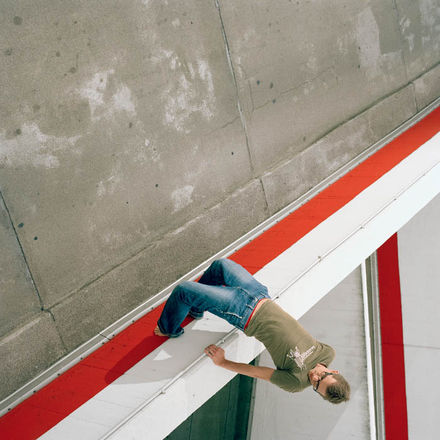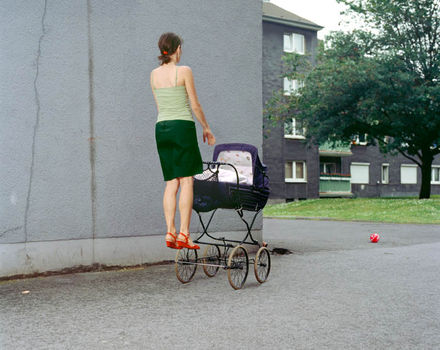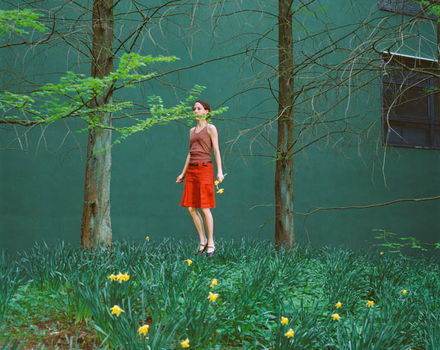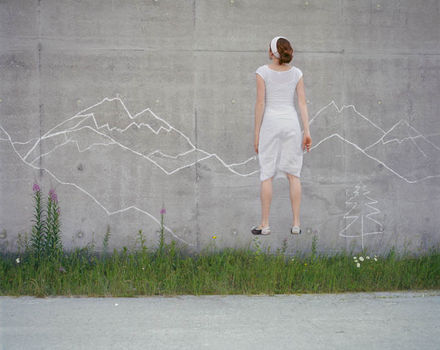Ivo Mayr part1: Leichtkraft and StadtLandFlucht
Following text (part1 and part2) and photographs by Ivo Mayr.
Leichtkraft
When I decided for a career as a photographer I quickly realized that it is not the simple representation of the environment which appeals to me in photography but more so the possibility to create new pictures. In my artistic work I am primarily interested in playing with the viewing habits of the observer. In my productions I am showing people (mostly individuals) in urban and rural environments. In their absurd, often comical poses physical laws seem to be abandoned. Through the irritation this creates the observer is forced to look closer in order to understand the unusual picture.
The interest for the theme of anti-gravity originated in 2005. In that time I experimented a lot with the rotation of images and perspectives and discovered that a picture could have a totally different meaning by its rotation. However this only works with pictures that already differ from the observer´s expected perspective, for example a narrow part of a concrete wall. In a picture with clearly defined objects (house, car, tree etc) the observer will quickly discover the rotation because he knows intuitively where upside and downside should be.
It is from this idea of a simple rotation that the series “Leichtkraft” originated. For this series I took pictures of people in public urban space with lots of spatial elements and worked on poses that seemed to defy the rules of gravity once the picture was rotated. It can only be seen at second glance where the effects of gravity are apparent: for example the falling of the hair or clothes which provides a crucial hint.
StadtLandFlucht
In the series “StadtLandFlucht” I let the people float as opposed to the people in the “Leichtkraft” series who always have firm ground under their feet. If Leichtkraft was a rather formal and graphical piece of work you could say StadtLandFlucht is a deeper discussion of an experience that I certainly share with lots of others: the experience to live at a place far away from where I was born and raised – far away from the place that I would call Heimat (home).
The incentive to move far away was the perspective of a life in the big city which was so different from what I knew, more exciting, wider and bigger. I found a lot of these aspects but at the same time realised that I also miss a lot of other aspects of my home. In this way my feeling of home only developed when I left and has grown ever since. On the other hand I can always feel a clear estrangement when I return home. The location of home is different in reality to the one carried in memories and longings.
This mental state between having lost the roots and longing is in the centre of the series “StadtLandFlucht”. The work shows people from both worlds: Heimat is portrayed as rural and the distance as urban environment. The people at the place of their home are strongly connected with the ground. This is where they have their roots. On the other hand they still don’t seem to really belong to their home environment. Their poses and behaviour don’t match the landscape, they look like they are about to trip over or fall, lose the ground under their feet and appear completely displaced.
The people who are far away from home on the other hand are shown floating. They carry home as an idea within themselves and even a simple trigger is enough to lift them out of their environment. They appear to be lost in reverie and not belonging to the concrete of the city. They lack the roots and have no firm connection with the ground. So in all pictures, the rural as well as the urban ones, there is a common feeling of being in between and not belonging.
Read the second part of the article: Passanten, by Ivo Mayr and visit Ivo Mayr website for more great content.














Ivo Mayr part2: Passanten
said, February 6, 2010 @ 9:48 pm :
[...] text (part1 and part2) and photographs by Ivo [...]